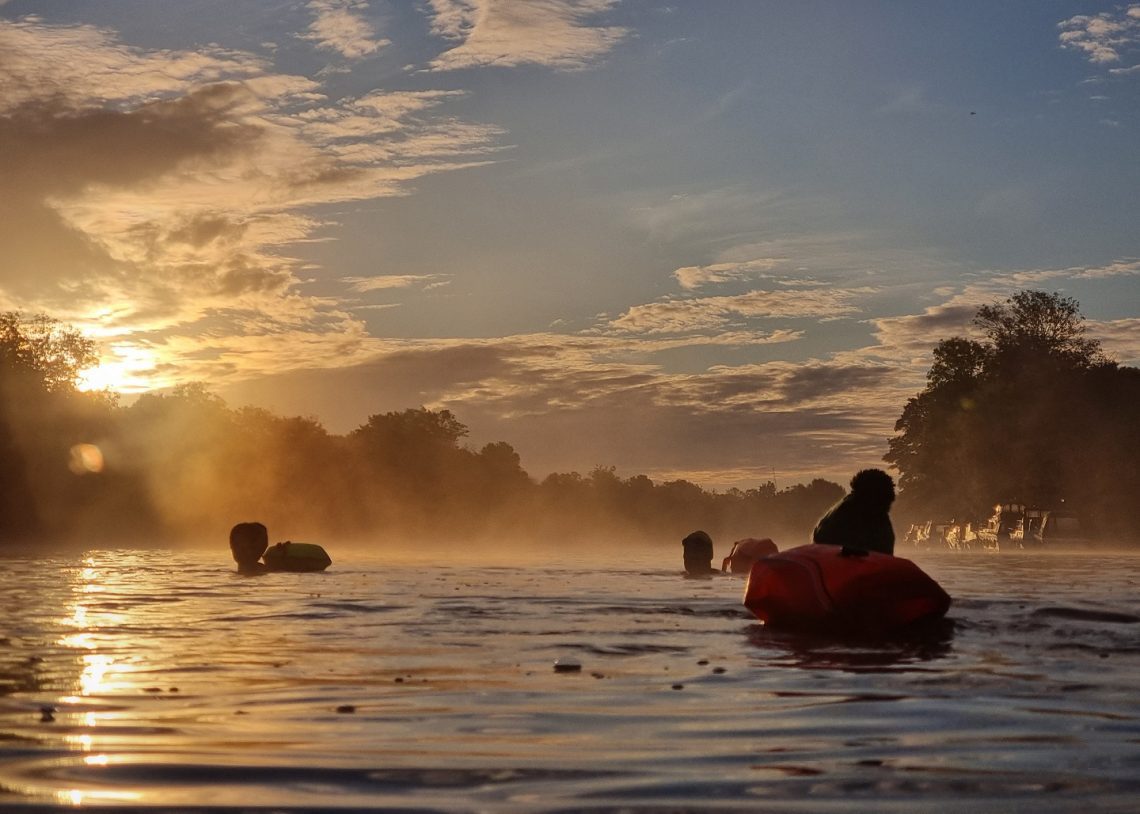
Is pollution in rivers getting worse? And what can you do about it?
Campaigners have elevated awareness of sewage pollution to the point that has become an important political issue. But how bad is it?
The current public concern about sewage pollution in rivers is a good thing. The more pressure people put on politicians, the more likely it is they will act to tackle the problem.
But there is a downside too. In our most recent Attitudes to Outdoor Swimming Survey, swimmers listed pollution as the biggest barrier to future growth in outdoor swimming.
We wanted to know how bad the situation is, and if it’s getting worse, so we asked Michelle Walker, Deputy Technical Director at the Rivers Trust.
“Unfortunately, we are confident that our rivers are in a critical state and that things are getting worse,” she says.
This is backed up by Surfers Against Sewage (SAS). They report that the environmental performance of the UK’s water and sewage companies fell to the lowest level on record in 2021. (Using data sourced from Environment Agency.)
One of the biggest concerns is sewage spills from Combined Sewer Outfalls (CSOs). Because many sewers carry both rainwater and domestic waste, the system can become overloaded after heavy rain. Water companies are permitted to spill untreated sewage into the environment to prevent sewers from backing up and flooding our houses. But this should only happen in extreme rainfall events. Unfortunately, evidence from event duration monitors (EDMs) at CSOs shows they spill more than they should. You can see this on the Rivers Trust’s Sewage Map.
Still, it’s hard to prove that CSOs are the main cause of deteriorating river quality.
“Water companies have only been required to monitor untreated sewage discharges for a few years,” says Walker. “We don’t have data on changes over a long time period and can’t separate out how much of the decline in river health is due to CSO spills versus other types of pollution and the many other pressures our rivers suffer from.”
On the other hand, we know there is a strong correlation between sewage discharges and reported illnesses. SAS track reported cases of illness linked to exposure to water through their Safer Seas and Rivers Service app, and they correlate those reports to known sewage discharges. They say that “between 1 October 2021 and 30 September 2022, 720 water users reported getting ill after entering the water.” Moreover, SAS found “39% of sicknesses reported via the app happened at a time of a confirmed sewage discharge notification.”
Pressure on the system
Urban development, growing population, more intense agricultural production and climate change have all harmed our rivers. The latter, for example, is leading to more frequent intense rainfall events, which overloads the combined sewer systems.
Nevertheless, we can’t shrug, blame population growth and climate change, and simply accept the degradation of our rivers. Surely the water companies need to account for this in their infrastructure investment planning?
They do, but as private businesses, they are also required to make a profit and deliver a return to their investors. Their capacity to increase revenue through charging customers more is limited by OFWAT, the water industry regulator, so they have a big financial incentive to reduce costs.
Walker says, “they should do this [reduce costs] only where they don’t compromise environmental performance. However, the only backstop is an ineffective regulatory system, where water companies monitor their own performance, legal permits are very difficult to enforce, and government agencies have nowhere near enough staff available to investigate abuses. Water companies therefore get away with ‘sweating the assets’ – if they reduce their capital expenditure (less frequent and less costly infrastructure upgrades, less backup and redundancy of critical infrastructure such as pumps), and their operational expenditure (less frequent maintenance, fewer staff, cutting treatment costs) then they can make more profit while keeping customer bills low. They can absorb the fines as an operating cost in the rare eventuality that they are prosecuted.”
Not just sewage
While sewage is part of the problem, there are many other pollution sources for which we have little data at a national scale, including septic tanks, agricultural runoff and road runoff. Walker says that where studies have been undertaken locally, these are shown to be having a massive impact on water quality.
“Untreated sewage spills, whilst undoubtedly causing a problem, are by no means the worst, or only, problem facing our rivers,” she concludes.
So how do we keep ourselves safe and how can we help clean up the mess?
Keeping safe
First, don’t panic. The majority of outdoor swims pass without incident, and mostly you can swim safely. And while there are no guarantees in open water, we can reduce our risks by being sensible about when and where we swim, and by being better informed. There are tools, for example, that provide live data on CSOs. A good place to start is the Sewage Pollution Alerts app (see below) created by Surfers Against Sewage, which mainly covers coastal CSOs. If you swim in the Thames Water catchment area, try their Event Duration Monitor (EDM) map. Or search Google for a local equivalent. These show you where CSOs are, if they’re currently discharging or if they have discharged in the previous 24 hours.
If you can’t find anything, then Walker suggests contacting your local water company and asking them for live CSO notifications. “They are all working on this and if they know a site is popular they may prioritise it or provide email notifications ahead of getting a live map service up and running,” she says.
If you want to take this further, then Walker says you could start a citizen science campaign. “Raise funding and test the water quality across a bathing water season to see when and where water quality is best. Get to know your local river including the upstream catchment. Head upstream and look for visible sources of pollution such as livestock accessing the river, manure heaps close to streams or rivers, outfall pipes or ditches with discoloured runoff, sewage fungus (grey pillowy deposits) or mats of algae coating the bed and banks. Look at the water colour. A grey sheen can indicate sewage pollution while a strong green colouration indicates an algal bloom that could be harmful to health. Talk to other swimmers – have any of them become sick after swimming here? Avoid swimming after rain. If you think there may be pollution, don’t put your face in the water, cover cuts and wash after your swim.”
Be part of the solution
We can reduce our own impact on combined sewers in several ways: some easy, others requiring investment. The Rivers Trust recommend the following:
- Reduce or slow storm runoff from your home. Don’t pave over gardens and driveways. Install water butts, green roofs, rain gardens, etc. to help keep clean rainwater separate from the sewer system.
- Help reduce blockages in pipes which can cause CSO spills. Don’t pour fat, oil or grease down the drain. Don’t put hair, dental floss, wet wipes, kitchen roll, medicines or anything other than the 3 Ps (pee, poo, paper) down toilets or drains.
- Reduce household water usage (shorter showers, dual flush toilets, installing a water meter). These all help protect our beleaguered rivers from drought and help reduce the volume of sewage in the network.
- Use environmentally friendly cleaning products. Trap plastic fibres when washing clothes.
- Ensure every appliance, sink and toilet in your house is connected to the foul water drain, not to a storm drain. The latter can often go straight to the river. Appliances connected in garages and outhouses are frequently connected to the wrong drain. If in doubt, consult a builder.
- If you have a septic tank, get it regularly serviced and ensure it is not polluting your local stream or river.
Make your voice count
- Write to your MP and let them know your views. Use the Rivers Trust’s sewage map to pull out stats for your local constituency and ask what they are doing to tackle the problem. Sewage is an election issue in many constituencies.
- Write to your water company – your voice as a customer counts for a lot – water companies are assessed for customer satisfaction and will respond to local pressure.
- Object to planning applications if the local sewage network is already failing to cope. Use the evidence from the sewage map or dig deeper and ask the water company for details of planned investments and local sewage treatment works capacity.
- Apply for designated bathing water status on your local river. Surfers Against Sewage are running a campaign to help (see below).
Finally, remember, we shouldn’t be made to stop swimming because of sewage pollution. Water companies should stop dumping sewage into our waterways because we swim in them.
Additional resources
Thames Water – Event Discharge Monitor Map: https://www.thameswater.co.uk/edm-map








